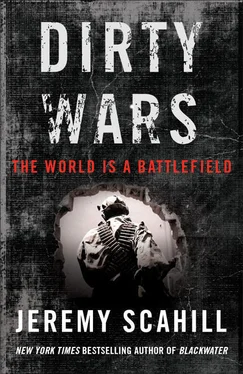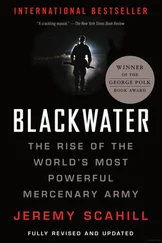Saleh was described as being “highly pissed” at the disclosure. “This is going to cause major problems for me,” Saleh complained to General Tommy Franks, the commander of CENTCOM. “This is why it is so difficult to make deals with the United States,” said Yemeni brigadier general Yahya M. al Mutawakel. “They don’t consider the internal circumstances in Yemen.” To the American intel and special ops community, which had cooked up a cover story with Saleh’s government to blame the hit on a truck bomb or a land mine, this was infuriating. But not everyone was displeased. When Senator Robert Graham, then chair of the Senate Intelligence Committee, was asked if the drone attack was “a precursor of more to come,” he replied bluntly, “I hope so.”
The targeted assassination of a US citizen away from the declared battlefield of Afghanistan sparked outrage from civil liberties and human rights groups. It was the first publicly confirmed targeted killing by the United States outside a battlefield since Gerald Ford implemented a ban on political assassinations in 1976. “If this was the deliberate killing of suspects in lieu of arrest in circumstances in which they did not pose an immediate threat, the killings would be extra-judicial executions in violation of international human rights law,” declared Amnesty International in a letter to President Bush. “The United States should issue a clear and unequivocal statement that it will not sanction extra-judicial executions in any circumstances, and that any US officials found to be involved in such actions will be brought to justice.”
Far from issuing such a statement, the Bush administration not only owned the operation but pushed back hard, asserting its right under US law to kill people it designated as terrorists in any country, even if they were US citizens. “I can assure you that no constitutional questions are raised here,” National Security Adviser Condoleezza Rice said on Fox News a week after the attack. “The president has given broad authority to U.S. officials in a variety of circumstances to do what they need to do to protect the country. We’re in a new kind of war, and we’ve made very clear that it is important that this new kind of war be fought on different battlefields.” She added, “It’s broad authority.”
The targeted killing didn’t just grab the attention of human rights groups. “To the extent you do more and more of this, it begins to look like it is policy,” said the CIA’s former general counsel, Jeffrey Smith. If used regularly, such attacks would “suggest that it’s acceptable behavior to assassinate people….Assassination as a norm of international conduct exposes American leaders and Americans overseas.”
In addition to launching a new kind of war in Yemen and the surrounding region, the drone strike that killed Hijazi would prove to be a precedent for Bush’s successor, Barack Obama, who nearly a decade later asserted the right of the US government to kill another US citizen in Yemen.
In the bigger picture, the 2002 Predator drone strike in Yemen was a seminal moment in the war on terror. It was the first time the CIA’s armed version of the Predator drone was used to attack al Qaeda outside Afghanistan. “It means the rules of engagement have changed,” an ex-CIA official familiar with special operations told the Los Angeles Times. The attack was an early salvo in the US government’s new borderless war. “The best way to keep America safe from terrorism is to go after terrorists where they plan and hide,” President Bush said in his weekly radio address after the drone strike. “And that work goes on around the world.” Bush reasserted that he had “deployed troops” in Yemen but emphasized they were only there in a training capacity.
As Bush spoke, plans were under way to put the new “world is a battlefield” doctrine into practice. In late 2002, US military and intelligence personnel worked around the clock upgrading and expanding Camp Lemonnier on the outskirts of Djibouti’s airport, preparing it for its role as a clandestine base of operations for JSOC and other special operations teams to strike at will against targets in Yemen and Somalia deemed to be terrorists under President Bush’s sweeping parameters of what constituted a combatant in the war on terror. On December 12, Donald Rumsfeld paid a surprise visit to the base as it was still under construction. “We need to be where the action is,” Rumsfeld told several hundred soldiers dressed in military fatigues. “There’s no question but that this part of the world is an area where there’s action.” He continued, “There are a number of terrorists, for example, just across the water in Yemen,” declaring, “These are serious problems.” That day, a US Army spokesman at Camp Lemonnier was asked if any missions had been launched from the new US base. “None that are conventional enough that we can speak about,” he replied. On December 13, the base officially became fully operational.
The US force in Djibouti was bolstered by more than four hundred soldiers and sailors aboard the USS Mount Whitney, a command-and-control ship sailing the Horn of Africa and the Gulf of Aden. Its official mission: detect, disorganize, defeat and deny terrorist groups posing an imminent threat to coalition partners in the region. “We’re coming, we’re hunting, we’re relentless,” declared the Whitney ’s senior officer, US marine major general John Sattler. His warship would help coordinate a covert US offensive encompassing Somalia, Yemen, Kenya, Ethiopia, Eritrea, Djibouti and Sudan. As Sattler spoke, in December 2002, his ship was decorated with paper Santas and other Christmas decorations, as well as a portrait of Osama bin Laden riddled with bullet holes. He described his mission as hunting terrorist leaders fleeing Afghanistan and heading to Yemen, Somalia and elsewhere in the region. “If they stumble, we’ll bring them to justice. Even if they don’t stumble, if they sleep a little too early one night or a little too late one morning, we’ll be there.”
Sattler refused to confirm his forces were involved in the November 2002 drone strike but said, “If I were a terrorist, and I thought I was happily driving down the road with my terrorist buddies, and all of a sudden—with no warning—I cease to exist, I would be looking left, right and, now, up, because we’re out there.” On December 22, Sattler met with President Saleh and other senior Yemeni officials in Sana’a. The US Embassy would not comment at the time about the meetings. The Yemeni government said only that the officials had discussed “coordination” in the “war against terrorism.” At the time, the New York Times characterized the views of a senior Bush administration official on Yemen: “As long as Mr. Saleh allows the C.I.A. to fly pilotless Predator drones over Yemeni territory and cooperates with American Special Forces and C.I.A. teams hunting for Qaeda members,” the administration would continue to back the Yemeni president.
The lethal US drone attack in Yemen and the construction of the base in Djibouti presaged an era of “direct action” by US counterterrorism forces in the region. “Needless to say a year ago, we weren’t here,” Rumsfeld said at Camp Lemonnier. “I suspect that if we looked out one or two or three or four years we would find that this facility would be here.” In addition to the conventional US military forces building up around Yemen and the Horn of Africa, US Special Operations Forces, including troops from JSOC, discreetly based at the time in Qatar and Kenya, were put on standby for more clandestine incursions into Yemen and its neighbor across the Gulf of Aden, Somalia. Although the CIA would take the lead in many of the future US operations in the region, it was a key moment in the rise of US Special Operations Forces, particularly JSOC, to a position of unprecedented influence within the US national security apparatus.
Читать дальше












